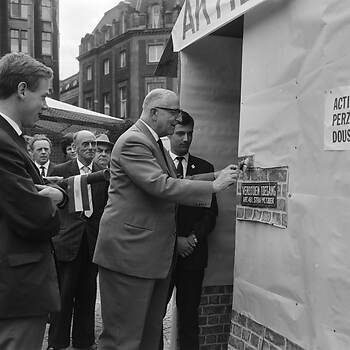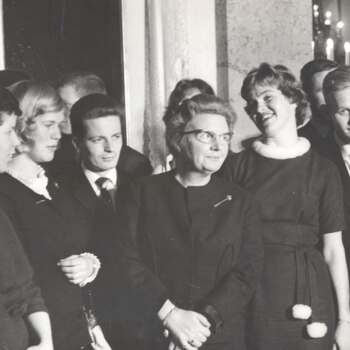The EWG
The European counterpart to John F. Kennedy’s Peace Corps (founded in 1960) was established in 1962 after a three-day meeting in Kaub am Reihn in Germany from June 1st to June 3rd. It was called the European Working Group (EWG). The Dutch Princess Beatrix founded and chaired the Board of this organisation. Other important members from the start were Laurens Jan Brinkhorst (then researcher at Leiden University, later member of D66 for whom he served as parliamentarian and minister), Bas de Gaay Fortman (then student and teacher at the Free University of Amsterdam, later member of the PPR), and Frans Alting von Geusau (who has just earned a doctorate in law, and later became a diplomat).
A year earlier Princess Beatrix delivered a speech in the French city of Toulouse at the European Cultural Foundation discussing the need for a common European ‘consciousness’ (bewustzijn). This can be seen as the start of her work on the EWG. According to university professor Alting von Geusau, who was present at the speech, it was “a call for active commitment to a united Europe in service of the world.” He later became chairman of the EWG-Board, while Princes Beatrix took up the role of President of the EWG.
The EWG aimed to contribute to a more united Europe in the service of people elsewhere. Specifically, they believed that European youths should voluntarily help others in need. After the earthquake of 1962 in Iran, the EWG ‘adopted’ a village in Northern Iran called Dousadj and launched a campaign to raise money in the Netherlands for its reconstruction. The first group of volunteers to go and rebuild houses consisted of Dutch, British and French people, as well as an Austrian, Australian, Swiss, American and a Swedish person. Learn more about this action and the EWG here and see the first picture above.
In the 1960s, the Netherlands (as well as other European states) also proceeded to create a national organisation for foreign voluntary service. The EWG only lasted six years and ceased operations in 1968. The main problem seemed to have been a lack of funds as the group failed to get access to subsidies, which often went to national agencies. In 2008, a booklet written by historian Peter Bak, was published ‘Young, inspired and committed, The chronicle of a European venture 1962-1968’ (Bewogen en bevlogen, Het Europees elan van prinses Beatrix), in which the EWG is discussed (A07521 in the NICC collection). Here you can find a short radio clip in which the author discusses the book and Princess Beatrix’s commitment to the EWG.
The JVP and JVC, and then the SNV (See also the 70+ OS timeline.)
In 1962 the Netherlands signed on to the International Secretariat for Volunteer Service (ISVS). Together with the other signatories, the Netherlands agreed to promote volunteering and the establishment of volunteer services to further development across the globe. In a later stage the ISVS was involved in establishing the United Nations Volunteers programme in 1970, discussed elsewhere in this timeline [hyperlink].
Two new national organisations were officially launched in the Netherlands in 1963. These were the state-run JVP and the JVC, a private organisation affiliated with several Christian groups. In the Western world, the early 60s witnessed a growing number of organisations with young volunteers seeking to ‘help’ abroad in ‘the Third World’. The success of the American Peace Corps is often seen as a major catalyst of this expansion. Researchers also point at earlier (Christian) youth movements (e.g. De Graal and de Katholieke Arbeidersjeugd (KAJ)), while, in the UK the Voluntary Service Overseas (VSO) was already launched in 1958.
As the movement within the Netherlands for concern with ‘the Third World’ and ‘the other’ had been growing since the 1950s (e.g. Queen Juliana’s speech of 1955), a protestant leader, Reverend Steenbeek, and the ‘Dutch Youth Community’ (Nederlandse Jeugd Gemeenschap, NJG) also started working on a novel youth voluntary service. It was envisioned as an over-arching organisation connecting established smaller initiatives into one youth voluntary service. Towards the end of 1962 the ‘Youth Volunteers’ Corps’ (Jongeren Vrijwilligers Corps, JVC) was founded, with the participation of around sixty Dutch civil society organisations, among them the Novib.
Just before the JVC planned to formally launch in February 1963, the Minister of Foreign Affairs, Luns, launched his own governmental volunteering initiative: the ‘Youth Volunteer Programme’ (Jongeren Vrijwilligers Programma, JVP). When a new cabinet started in the same year – the cabinet-Marijnen – the position of deputy minister for development cooperation was created, filled by Isaäc Nicolaas Theodoor Diepenhorst.
A few months later, several projects were being researched and designed, and in June 1963 the first JVP group was scheduled to leave for Cameroon. Before the young volunteers left, the Royal Tropical Institute (KIT) provided training for the first batch of volunteers. This consisted of English classes, theoretical classes by university professors and practical lessons. There was not much attention for the host country’s culture and history, as scouting-type practices were considered more important. This approach was consistent with the ‘modernisation’ idea of development that was prominent in the 1960s. The goal was to change ‘the Third World’, rather than to study it. Unlike the American Peace Corps, all participants in the Dutch volunteer service had completed their higher education and they were selected because of their knowledge of topics that were seen as relevant to development, including education, health care, agricultural research and extension, road construction, and more.
With a little delay, the first team of the governmental JVP left on the 19th of November 1963, after a reception at the royal palace (see picture 2). When they arrived in Cameroon, it became apparent that the project that was planned could not be implemented. The plan was to work at a certain school. However, this school did not exist anymore. The young volunteers thus had to figure out by themselves what they could do to help local people in villages, with many of them focusing on agricultural improvements. In the podcast “Het Spoor”, the stories of the first Dutch volunteers to Cameroon are told.
Later, Dutch volunteer teams went to places in Brazil, Colombia, India, and Palestine. In the initial years of its existence, the governmental JVP operated rather chaotic, due to insufficient preparation and no clearly defined objectives for projects. The work of the Dutch volunteers in the 1960s was sometimes appreciated, while there were also frictions between local people and/or governments and the young volunteers, for example in Cameroon.
The government’s response to the plans to establish the JVC as a civil society organisation—the foundation of the governmental JVP—was not uncontroversial. It led to conflicts between the private organisations in the JVC, other organisations, and the central government in The Hague. Between 1962 and 1965, several dialogues were organised. The JVC was particularly upset because the state cited the American Peace Corps (even though the British Voluntary Service Overseas (VSO) started in 1958) as its sole source of inspiration and seemed to overlook the initiatives of JVC member organisations. After months of negotiations, the Dutch Volunteers Foundation (Stichting Nederlandse Vrijwilligers, SNV) was formed, as a merger between the JVP and the JVC.
In 1965 the SNV was established as a foundation with a board that would work closely together with the Minister for Development Cooperation in the Ministry of Foreign Affairs. The volunteers got a 2-year contract with the SNV, after which they would return to the Netherlands. Initially the JVP, and then the SNV, were rather unstable organisations. In 1966, the SNV (formerly the JVP) was already under the leadership of its 5th director.
SNV-volunteers had to cooperate with the government and civil society organisations in host countries and focus as much as possible on the local way of working. The goal of the SNV was to share (practical) knowledge with local populations. Between 1965 and 1974, 80 projects were started, with 1,417 volunteers being send to eighteen different countries.
In 1967, the SNV launched a magazine called Vice Versa, which aided the SNV’s secondary goal of promoting awareness of development in Dutch society. The magazine became a way for Dutch youth who volunteered or worked in developing countries to voice their discontent and disagreement with the (increasing) gap in development between the ‘first’ and ‘third world’. The SNV worked together with the foundation Socutera, which agreed to make films of ten to twenty minutes in which SNV projects abroad were highlighted. The films portrayed the projects in a positive light, but there was also rooms for the difficulties and problems that occurred.
Sources and further reading:
- Andere Tijden, “Iran/ Springschoenen”.
- The Podcast “Het Spoor”, 2016.
- About us page, website SNV 2011
- Brinkman, I. (2010). Bricks, Mortar and Capacity Building: A Socio-Cultural History of SNV Netherlands Development Organisation. Leiden [etc.]: Brill.
- SNV, “50 years later the impact of our work is still visible”, 2016.
- Fragment from OVT “Het europees elan prinses Beatrix”, 2005.

